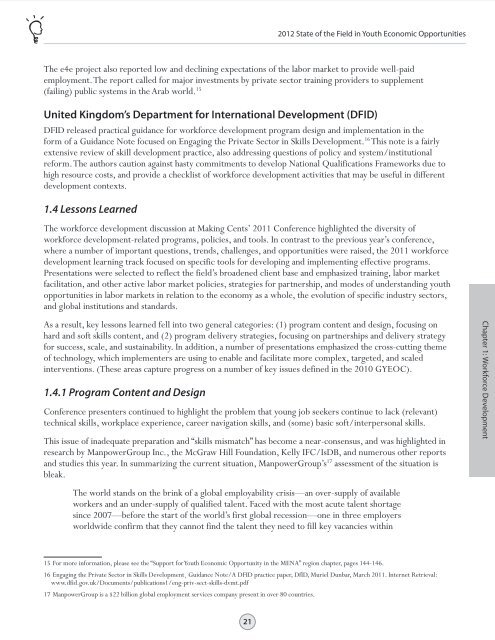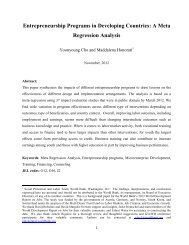STATE OF THE FIELD IN YOUTH ECONOMIC OPPORTUNITIES
STATE OF THE FIELD IN YOUTH ECONOMIC OPPORTUNITIES
STATE OF THE FIELD IN YOUTH ECONOMIC OPPORTUNITIES
Create successful ePaper yourself
Turn your PDF publications into a flip-book with our unique Google optimized e-Paper software.
Table of Contents<br />
Chapter 1 Chapter 2 Chapter 3 Chapter 4 Chapter 5 Chapter 6 Chapter 7 Chapter 8<br />
Chapter 9<br />
Chapter 10 Chapter 11 Chapter 12 Chapter 13 Chapter 14 Chapter 15 Annexes<br />
2012 State of the Field in Youth Economic Opportunities<br />
The e4e project also reported low and declining expectations of the labor market to provide well-paid<br />
employment. The report called for major investments by private sector training providers to supplement<br />
(failing) public systems in the Arab world. 15<br />
United Kingdom’s Department for International Development (DFID)<br />
DFID released practical guidance for workforce development program design and implementation in the<br />
form of a Guidance Note focused on Engaging the Private Sector in Skills Development. 16 This note is a fairly<br />
extensive review of skill development practice, also addressing questions of policy and system/institutional<br />
reform. The authors caution against hasty commitments to develop National Qualifications Frameworks due to<br />
high resource costs, and provide a checklist of workforce development activities that may be useful in different<br />
development contexts.<br />
1.4 Lessons Learned<br />
The workforce development discussion at Making Cents’ 2011 Conference highlighted the diversity of<br />
workforce development-related programs, policies, and tools. In contrast to the previous year’s conference,<br />
where a number of important questions, trends, challenges, and opportunities were raised, the 2011 workforce<br />
development learning track focused on specific tools for developing and implementing effective programs.<br />
Presentations were selected to reflect the field’s broadened client base and emphasized training, labor market<br />
facilitation, and other active labor market policies, strategies for partnership, and modes of understanding youth<br />
opportunities in labor markets in relation to the economy as a whole, the evolution of specific industry sectors,<br />
and global institutions and standards.<br />
As a result, key lessons learned fell into two general categories: (1) program content and design, focusing on<br />
hard and soft skills content, and (2) program delivery strategies, focusing on partnerships and delivery strategy<br />
for success, scale, and sustainability. In addition, a number of presentations emphasized the cross-cutting theme<br />
of technology, which implementers are using to enable and facilitate more complex, targeted, and scaled<br />
interventions. (These areas capture progress on a number of key issues defined in the 2010 GYEOC).<br />
1.4.1 Program Content and Design<br />
Conference presenters continued to highlight the problem that young job seekers continue to lack (relevant)<br />
technical skills, workplace experience, career navigation skills, and (some) basic soft/interpersonal skills.<br />
This issue of inadequate preparation and “skills mismatch” has become a near-consensus, and was highlighted in<br />
research by ManpowerGroup Inc., the McGraw Hill Foundation, Kelly IFC/IsDB, and numerous other reports<br />
and studies this year. In summarizing the current situation, ManpowerGroup’s 17 assessment of the situation is<br />
bleak.<br />
The world stands on the brink of a global employability crisis—an over-supply of available<br />
workers and an under-supply of qualified talent. Faced with the most acute talent shortage<br />
since 2007—before the start of the world’s first global recession—one in three employers<br />
worldwide confirm that they cannot find the talent they need to fill key vacancies within<br />
Chapter 1: Workforce Development<br />
15 For more information, please see the “Support for Youth Economic Opportunity in the MENA” region chapter, pages 144-146.<br />
16 Engaging the Private Sector in Skills Development¸ Guidance Note/A DFID practice paper, DfID, Muriel Dunbar, March 2011. Internet Retrieval:<br />
www.dfid.gov.uk/Documents/publications1/eng-priv-sect-skills-dvmt.pdf<br />
17 ManpowerGroup is a $22 billion global employment services company present in over 80 countries.<br />
21

















